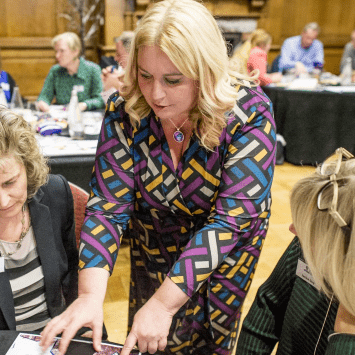Posted in Blog, Design Thinking, Facilitation, Innovation, Meetings, Virtual Facilitation by Jo North
Lightning Talks: An Introduction
Lightning talks are short presentations that pack a powerful punch in terms of content and engagement. They’re especially useful during innovation and design sprints, offering a quick-fire way to explain a problem and any constraints, share ideas, spark new conversations, and fuel the creative process. This guide walks you through everything you need to know about using lightning talks in your innovation sprints and design sprints. I also cover how to make your lightning talk a success.
What Are Lightning Talks?
At their core, lightning talks are brief, typically around five to seven minutes. They’re designed to convey a key message or idea succinctly and effectively. This format encourages speakers to focus on the most important parts of their message, making them a valuable tool for sprint participants.
Speakers prepare powerpoint slides with clear bullet points, ensuring their message is direct and to the point. The short time limit helps maintain a brisk pace and keeps the audience engaged.
How to Use Lightning Talks in Your Innovation and Design Sprints
I tend to use lightning talks at the beginning of a sprint, to set the scene and make sure that participants have a thorough understanding of the problem statement and its requirements before ideation activities begin. I also place “wild card” lightning talks at different points throughout longer design and innovation sprints. The purpose of this is to firstly give participants a short mental break from direct problem solving, allowing their creative subconscious some time and space to work in the background. In these middle stages I also want to disrupt and re-energize participants’ thinking. This is where the “wild card” element is so important. I’ll usually invite someone from another industry who has successfully tackled a similar challenge previously, or a key stakeholder with a fresh perspective.
Longer Lightning Talks for Complex Research and Technical Challenges
Whilst many facilitators aim for around seven minutes per lightning talk, I’ll suggest slots of 10-15 minutes to my delegates. This is because I often facilitate sprints with academics and experts focused on complex technical issues, and those few extra minutes help to provide sufficient depth for the sprint. I find that I will often need to ‘coach’ people that I have invited to give lightning talks before the event. These are often senior people, many have deep technical expertise or have undertaken detailed research. They are used to presenting in the conventional format and timescales, having much more time and being able to cover more detail. However, with support, they are all usually up for the challenge and enjoy doing things differently. An additional benefit is that their talks are well-received and appreciated for their focus and punchiness.

Scheduling Your Lightning Talks
When I’ve scheduled lightning talks towards the beginning, or in the middle of a sprint, I ask delegates to engage in active listening. I brief them to grab a stack of real or virtual sticky notes, depending on whether the sprint is in-person or online, of course, and to individually write down ideas and questions that occur to them during the lightning talk. This way, we make sure that useful thinking isn’t lost. After the lightning talk I’ll ask them to work in breakouts to share their questions and ideas, and integrate them into their work.
Finally, towards the end of the sprint, I ask delegates to present the solutions they have been working on to each other, and sometimes users or customers, in the lightning talk format. Doing so keeps things pacy and focused, which is especially important after everyone has been working so hard throughout the sprint. It ensures that energy remains high, and the sprint is enjoyable and productive to the end.
Planning to Give a Lightning Talk
Focus on Key Points
When you’re planning to give a lightning talk, the most important thing is to select a specific topic and stick to it. Whether it’s a research project, a technical challenge, new product feature, or an innovative design idea, ensure your talk is focused. Bullet points on your slides can help keep your message clear and prevent you from straying off topic. Make your slides visual and don’t overload them with data.
Keep It Short and Sweet
Given the short time frame, you’ll need to distill your content to its essence. Think about what your audience needs to know and what you want them to remember. This isn’t the time for an in-depth analysis; instead, highlight the key points that will inspire and inform.
Engage the Audience
The success of your lightning talk often hinges on how well you connect with your audience. Ask questions, include short, relatable anecdotes, and use visual aids to make your points more vivid. Remember, the goal is to spark new conversations and ideas, not just present data.
Submission and Selection
If you want to submit a ‘pitch’ to give a lightning talk at a sprint, conference or other event, submissions usually involve a brief overview of your topic. Being the primary author, your submission should outline the significance of your talk and why it would be of interest to the audience. Keep your description punchy, focusing on the transformation or impact that your lightning talk will have, rather than the detail of what you’ll cover. Selection for lightning talk slots is often competitive, and fitting your idea into the specific format can increase your chances of being chosen.
Best Practices
Rehearse
As with any presentation, practicing your talk is crucial. Time yourself to ensure you stay within the given time limit. Rehearsing in front of colleagues or friends can provide valuable feedback and help you refine your lightning talk.
Visuals Matter
Powerpoint slides should complement your talk, not detract from it. Use visuals that reinforce your message and remember, less is more. Avoid cluttering slides with too much information.
Be Ready for Feedback
Lightning talks are a great way to test ideas and get feedback. Be prepared for questions and even written comments from audience members. This feedback can be invaluable for refining your ideas or research.
Next Steps
Lightning talks are a great way to share ideas quickly, making them an ideal format for innovation and design sprints. They encourage speakers to concentrate on the essence of their message. The result will be a platform for sparking new conversations and collaborations. By following this guide, your innovation or design sprint will feature successful lightning talks. These will captivate and inform your audience, contributing to better sprint outcomes.
If you’d like any help with your innovation sprints or design sprints, please do get in touch here. I’ll reply to book in a no-obligation Teams or Zoom call to discuss your event. I’m looking forward to hearing from you!


